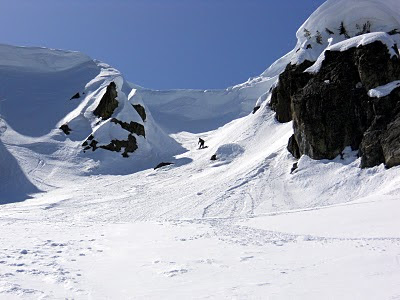On our first day we explored the Castle Peak area just off of the freeway near Donner Pass (about 10 minutes from Truckee). We were quite pleased with what we found.
While wandering around on our first day, we stumbled upon this obvious couloir line on Castle Peak. We started late and hit the snow at the perfect time of day!
Ava skiing down the couloir on Castle Peak
The skiing below the couloir was the best, so we made a second lap on the lower part before calling it a day. The next two days we stayed pretty close to the house. We went skate skiing with Ava's mom, Nancy, one day and made laps in the backyard the other.

Nancy having less than a lot of fun on skate skis
Ava and Nancy had never skate skied before, and I hadn't done it in about a year, so that was a lot of lung-busting fun. While making laps in the backyard, we built a kicker (or "booter" if that's your preferred nomenclature) and proceeded to jump over a baby.

Me jumping over Blair
We were joined for the weekend by a slew of friends and relatives. So, the following day, Ava went resort skiing with a bunch of her good friends from the Bay area while Dane and I went and explored some more in the Donner Pass area. We found super windy conditions and a lot of short but well-featured lines.
The skiing wasn't great, so we experimented with ski-bouldering near the top of Donner Peak
We also dabbled in cornice breaking. This failure didn't last long, but the rock that eventually broke it took both of us to lift, so we didn't get it on video.
We also skied
The next two days we got serious and drove an hour each way to the South Lake Tahoe area to ski some classic Tahoe peaks: Talac and Echo. Talac provided us with amazing views of Lake Tahoe most of the way up. It was a weekday, but we saw no less than 10 other people climbing and skiing the same route. The pictures tell the story better than I can.
The upper bowl on Mt. Talac
Making a fashion statement
Skiing the upper bowl
Things were melting out fast, but that didn't stop us from being ridiculous.
Echo Peak was in the same area, but we couldn't see the lake for the first half of the ascent, so it lost aesthetic points. However, the amazing terrain at the top of the peak more than made up for the short coming. With a well setup snowpack, we decided it was reasonable to ski some steeper lines.
Skinning up through the big burn
Assessing the skiability of the snow arete and deciding which side to ski down. I opted to eventually drop off the right (near) side while Ava and Dane dropped off the left side.
One of the more committing turns I've ever made
Ava getting ready to drop in
Ava below the threatening cornice
Dane styling the chute
After this incredible descent, which we eventually got cliffed out on, we made a second lap to ski the aspect that led to the car. The skiing was great, but aside from the cornice at the top, it was much less dramatic than the other side.
Dane hucking on our second lap
Day 7 was a repeat of Day 1 up at Castle peak. The differences were that this time we had Dane with us, the couloir was icy, and it was so much more melted out that it wasn't skiable in its entirety. We planned to drive that evening to Mt. Shasta in attempt to put an amazing close to our spring break ski trip with a 7,300 vertical foot run from the summit. The clear skies that were forecasted did not show themselves. It snowed about 4 inches the night we arrived and continued snowing throughout the next day. After sleeping in, we got up to ski some powder and managed to get within 6,000 vertical feet of our objective. We made two laps from treeline in powder over icy crust, then drove to Eugene to stay the night with Jake. I think this is long enough, so I'll elaborate no further.




















































